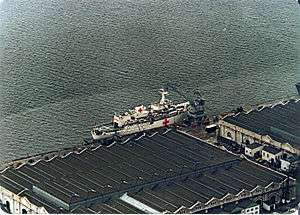HMS Hecla (A133)
 Hecla at HM Naval Base Gibraltar, during conversion to an Ambulance Ship for use during the Falklands War | |
| History | |
|---|---|
| Name: | HMS Hecla (A133) |
| Builder: | Blythswood |
| Laid down: | 6 May 1964 |
| Launched: | 21 December 1964 |
| Completed: | 24 August 1965 |
| Commissioned: | 1964 |
| Identification: | IMO number: 4902426 |
| Fate: | Sold 1997 |
| General characteristics | |
| Displacement: | 2,800 tons full load |
| Length: | 79 m (259 ft 2 in) |
| Beam: | 15.4 m (50 ft 6 in) |
| Draught: | 4.9 m (16 ft 1 in) |
| Propulsion: | 3 × Paxman Ventura V-12 diesel engines |
| Speed: |
|
| Range: | 12,000 nmi (22,000 km) at 11 kn (20 km/h) |
| Complement: | 121 |
| Aircraft carried: | 1 × Westland Wasp light helicopter |
| Service record | |
| Operations: | Falklands War |
HMS Hecla was the lead ship of the Hecla class, an oceangoing survey ship type in the Royal Navy. She was ordered in the mid-1960s, along with her sister ships HMS Hecate and HMS Hydra. A fourth ship, HMS Herald, was completed in the early 1970s. The ship served for thirty years in this role, and various others, before finally being replaced by HMS Scott in 1997. Hecla was sold to private interests, being renamed "Bligh" after Vice-Admiral William Bligh. After this, the vessel was used in a hydrographic survey of Irish waters, and was based in Waterford, Ireland.
In 1982, Hecla was used as an ambulance ship for the duration of the Falklands War. In this role, she ferried wounded from both sides to the main hospital ship, SS Uganda.
External links
- MaritimeQuest HMS Hecla A-133 pages
- Lenton, H.T. (1966). Warhips of the British and Commonwealth Navies. London: Ian Allan.
This article is issued from
Wikipedia.
The text is licensed under Creative Commons - Attribution - Sharealike.
Additional terms may apply for the media files.